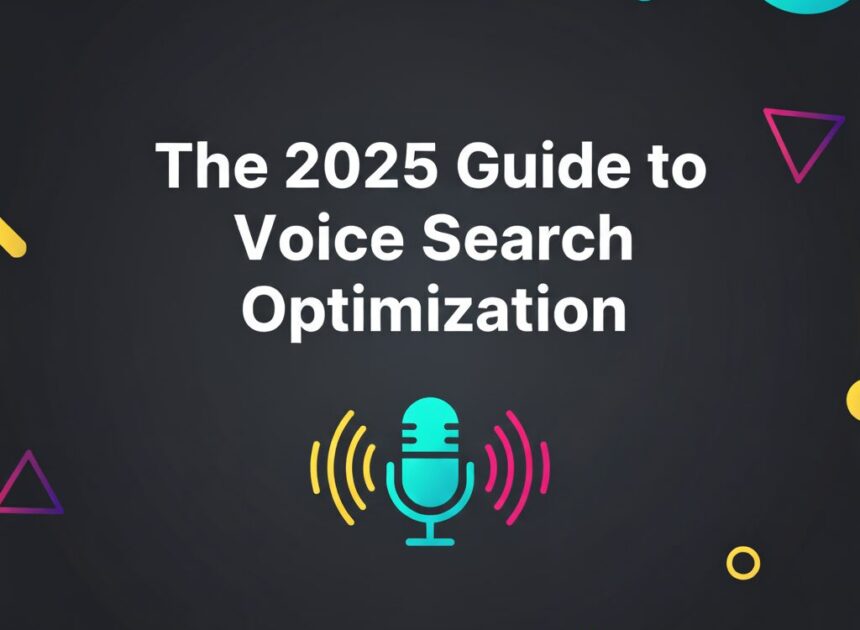Hey Google, how is search changing? The answer is clear: more people are asking, not typing. The explosive growth of voice assistants like Siri, Alexa, and Google Assistant has fundamentally shifted user search behavior from stilted keywords to natural, spoken questions. This isn’t a fleeting trend; it’s the new frontier of digital interaction. To stay competitive, your SEO strategy must evolve.
This guide provides a tactical roadmap for implementing a future-proof voice search optimization strategy. By following these steps, you can capture this growing, high-intent traffic and ensure your brand is the one providing the answers in 2025.
Why Voice Search SEO Demands a New Approach
You can’t simply apply old SEO rules and expect to win at voice search. The very nature of how people ask questions verbally requires a strategic pivot. It’s about understanding the nuances of spoken language and the intent behind every query.
The Shift from Keywords to Conversations
When people type, they use shortcuts. A search for “best pizza Chicago” is typical. But when they speak, they use full sentences. They ask, “Hey Google, what’s the best deep-dish pizza place near me in Chicago?”
This shift means your content needs to mirror this conversational style. Focusing solely on short-tail keywords will cause you to miss the vast majority of voice search traffic. The goal of modern voice search SEO is to align your content with the natural language your customers use every day.
Understanding User Intent: Informational, Navigational, and Transactional Voice Queries
Every search query has an intent behind it, and voice search makes this intent crystal clear. Understanding these categories is key to creating the right content.
- Informational: The user is looking for an answer to a specific question. For example, “How do you make a sourdough starter?” or “What is the capital of Australia?”
- Navigational: The user wants to go to a specific website or location. For instance, “Take me to Nike.com” or “Directions to the nearest Target.”
- Transactional: The user is ready to make a purchase or take a specific action. Queries like, “Order a large pepperoni pizza from Domino’s” or “Book a flight from JFK to LAX for next Tuesday.”
To optimize for voice search, you need to create content that serves all three intents, with a particular focus on informational queries that can lead to transactions.
Step 1: Master Conversational & Long-Tail Keywords
The foundation of a strong voice search optimization strategy is understanding and targeting the exact phrases your audience is speaking. This means moving beyond single keywords and embracing the full context of their questions.
Thinking Like a User: The Power of Conversational Keywords
Conversational keywords are longer, more natural-sounding phrases that mimic real speech. Instead of targeting “page speed,” you would target “how do I improve my website’s page speed?”
To start, think about how you and your friends ask for information. You don’t speak like a robot; you have conversations. Brainstorm the questions your customers might ask about your products, services, or industry. This mindset shift is the first and most crucial step.
How to Research Question-Based Keywords
The most effective voice search keywords are structured as questions. Build your research around the “5 Ws and an H”:
- Who is the best provider for…?
- What are the benefits of…?
- Where can I find…?
- When is the best time to…?
- Why should I choose X over Y?
- How do I set up…?
Practical Tools for Finding Voice Search Queries
- AnswerThePublic: Generates hundreds of question-based searches for any topic.
- Google’s “People Also Ask”: Offers real-world queries you can use for FAQs and subheadings.
- Google Autocomplete: A simple but effective way to discover long-tail, popular voice queries.
Step 2: Structure Your Content for Voice Answers
Once you know what people are asking, structure your content to provide clear, direct answers. Search engines prioritize clarity and conciseness when sourcing answers for voice assistants.
Aim for “Position Zero”: How Featured Snippets Fuel Voice Search
Featured Snippets (Position Zero) are the top answer boxes on Google. Over 40% of voice search answers come directly from these snippets.
To capture this spot, provide succinct answers in short paragraphs, bulleted lists, or numbered steps.
Create Concise, Direct Answers at the Beginning
Don’t bury the lede. Answer the user’s question immediately within the first paragraph under the relevant heading. Keep it under 30 words, then expand in detail below.
Implementing FAQ Schema
FAQ schema tells Google, “This content is a question, and this is the answer.” Adding this structured data dramatically improves your chances of ranking in voice results.
Ways to implement:
- Use a CMS plugin like Yoast or Rank Math.
- Or, add JSON-LD markup directly into your page’s code.
Step 3: Optimize for Local “Near Me” Searches
A significant percentage of voice searches are local. Think: “Where’s the nearest coffee shop?”
Optimize Your Google Business Profile (GBP)
- Complete every field with accurate details.
- Keep your hours, address, and contact info current.
- Add photos, posts, and respond to reviews regularly.
Ensure NAP Consistency
Your Name, Address, and Phone number must match across your website, directories, and social platforms.
Build Content Around Local Landmarks
Weave your location into your content. Examples:
- “5 Things to Do Near [Local Landmark] This Weekend.”
- Neighborhood-specific service pages.
- Copy that naturally mentions nearby areas.
Step 4: Technical Must-Haves for Voice SEO
Without strong technical SEO, content won’t rank in voice searches.
Page Speed Matters
The average voice search result loads in 4.6 seconds—52% faster than most pages. Use image compression, caching, code minimization, and a CDN.
Mobile-First Experience
Most voice searches happen on mobile. Your site must be fully responsive and easy to navigate on small screens.
Use Structured Data
Beyond FAQ schema, add:
- LocalBusiness schema: For location accuracy.
- HowTo schema: For step-by-step guides.
- Product schema: For e-commerce details like price and reviews.
Conclusion: Speak Your Customer’s Language
As 2025 approaches, the line between searching and speaking will continue to blur. Winning in this landscape means creating content that serves people, not just algorithms.
Key takeaways:
- Focus on conversational, question-based keywords.
- Structure content for snippets and add FAQ schema.
- Dominate local SEO with GBP and NAP consistency.
- Ensure speed and mobile-first usability.
The future of search is spoken. Start optimizing today so your brand is ready to answer when your customers ask.







